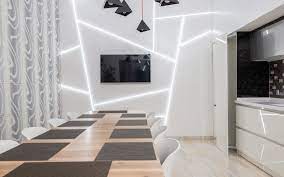Cove lighting is a versatile and elegant lighting technique that has become increasingly popular in interior design. This subtle and indirect lighting method not only enhances the overall aesthetic appeal of a space but also contributes to creating a warm and inviting atmosphere. In this article, we will explore the concept of cove lighting, its various applications, and the transformative impact it can have on different environments.
Understanding Cove Lighting:
Cove lighting involves the placement of light fixtures in recessed ledges, niches, or valances to create a gentle, indirect illumination. The fixtures are typically concealed, allowing the light to reflect off ceilings or walls, resulting in a soft and ambient glow. This method is especially effective in eliminating harsh shadows and providing a more even distribution of light throughout a room.
Versatility in Applications:
Cove lighting is incredibly versatile, finding applications in various settings and design styles. From residential spaces to commercial establishments, its adaptability makes it a favorite among interior designers. Common applications include:
Living Spaces:
Cove light can be used in living rooms, bedrooms, or hallways to create a cozy and relaxed atmosphere. By strategically placing the fixtures, it can highlight architectural features, accentuate wall textures, or even serve as a primary source of ambient lighting.
Restaurants and Hospitality:
In restaurants and hotels, cove lighting is often employed to establish a welcoming and sophisticated ambiance. It can be used to delineate different areas, such as dining spaces or reception areas, contributing to the overall design concept.
Retail Environments:
Retailers use cove lighting to enhance product displays and create an appealing shopping experience. The soft illumination draws attention to merchandise without creating harsh shadows, making it an ideal choice for showcasing products.
Art Galleries and Museums:
In art galleries and museums, cove lighting is a preferred method for showcasing artworks. Its ability to provide uniform lighting without causing glare or damage to delicate pieces makes it a popular choice among curators and exhibition designers.
Types of Cove Lighting:
Cove lighting comes in various forms, allowing designers to choose the style that best suits the intended aesthetic. Some common types include:
Concealed Cove Light:
Concealed cove light hides the light source within a recess, creating a seamless and clean look. This type is often used to wash walls with light, providing a soft and uniform glow.
Exposed Cove Lighting:
Exposed cove light features visible fixtures within the cove, adding an architectural element to the design. This style can contribute to a modern and industrial aesthetic, especially when using sleek and minimalistic fixtures.
Floating Coves:
Floating coves create the illusion of light hovering within a space. This effect is achieved by placing the light fixtures in a recessed area that is visually separated from the surrounding surfaces.
Molding or Trim Coves:
Molding or trim coves integrate lighting into architectural details such as crown molding or trim. This approach adds a touch of sophistication to the space and can be customized to complement specific design styles.
Color Temperature and Mood:
Cove lighting allows for flexibility in choosing color temperatures, influencing the mood of a space. Warm color temperatures (around 2700K) create a cozy and intimate atmosphere, ideal for residential spaces. Neutral or cool temperatures (between 3500K and 4000K) are commonly used in commercial settings to promote alertness and focus.
Energy Efficiency and Longevity:
Advancements in LED technology have made cove light more energy-efficient than ever. LED cove lights consume less energy, have a longer lifespan, and produce less heat compared to traditional incandescent or fluorescent options. This makes them an environmentally friendly and cost-effective choice for both residential and commercial applications.
**5. Design Tips for Cove Lighting:
Consider the Architecture:
When incorporating cove light, consider the architectural features of the space. Highlighting specific elements such as archways, tray ceilings, or alcoves can add depth and visual interest.
Layering with Other Light Sources:
Combine cove lighting with other light sources, such as pendant lights or wall sconces, to create a layered lighting scheme. This approach ensures that different areas of the room receive the appropriate illumination for their function.
Dimming Controls for Flexibility:
Install dimming controls to adjust the intensity of cove light according to different activities and moods. Dimmers provide flexibility, allowing you to tailor the lighting to specific needs, whether it’s entertaining guests or creating a relaxed ambiance.
Professional Installation:
Due to the placement and complexity of cove lighting systems, it’s advisable to seek professional assistance for installation. Professional installers can ensure that the fixtures are securely in place and that the lighting achieves the desired effect.
Conclusion: Transformative Illumination
Cove lighting, with its versatility and aesthetic appeal, has proven to be a transformative element in interior design. Whether used to create a cozy residential haven, a sophisticated commercial environment, or to showcase artworks in museums, cove lighting contributes to the overall ambiance and functionality of a space. With various types and styles to choose from, it allows designers and homeowners to customize the lighting to suit their specific preferences and design concepts. As advancements in technology continue, the future of cove lighting holds even more possibilities for creating enchanting and captivating illuminated environments.

